HRM3004S - Employee Engagement Strategies & Impact in DBS Bank
VerifiedAdded on 2022/11/22
|18
|7753
|2
Literature Review
AI Summary
This literature review explores employee engagement strategies within DBS Bank, focusing on how these strategies contribute to organizational performance, productivity, and employee retention. It highlights DBS's commitment to simplifying banking, attracting and retaining talent, and fostering a supportive workplace environment. The review examines the bank's 'triple E' framework (exposure, experience, and education) for talent development, its emphasis on diversity, and its use of gamification to enhance employee engagement. It further discusses the importance of employee engagement for sales, profitability, productivity, absenteeism, and turnover. The review also delves into DBS's '10 C's' of employee engagement: Connect, Career, Clarity, Convey, Congratulate, and Contribute, which aim to foster a sense of value, provide career opportunities, communicate a clear vision, offer feedback, recognize contributions, and connect work to strategic objectives. The review concludes that DBS's engagement efforts have significantly improved employee engagement levels, leading to a competitive advantage.

Management Theory and Practice
Paraphrase This Document
Need a fresh take? Get an instant paraphrase of this document with our AI Paraphraser
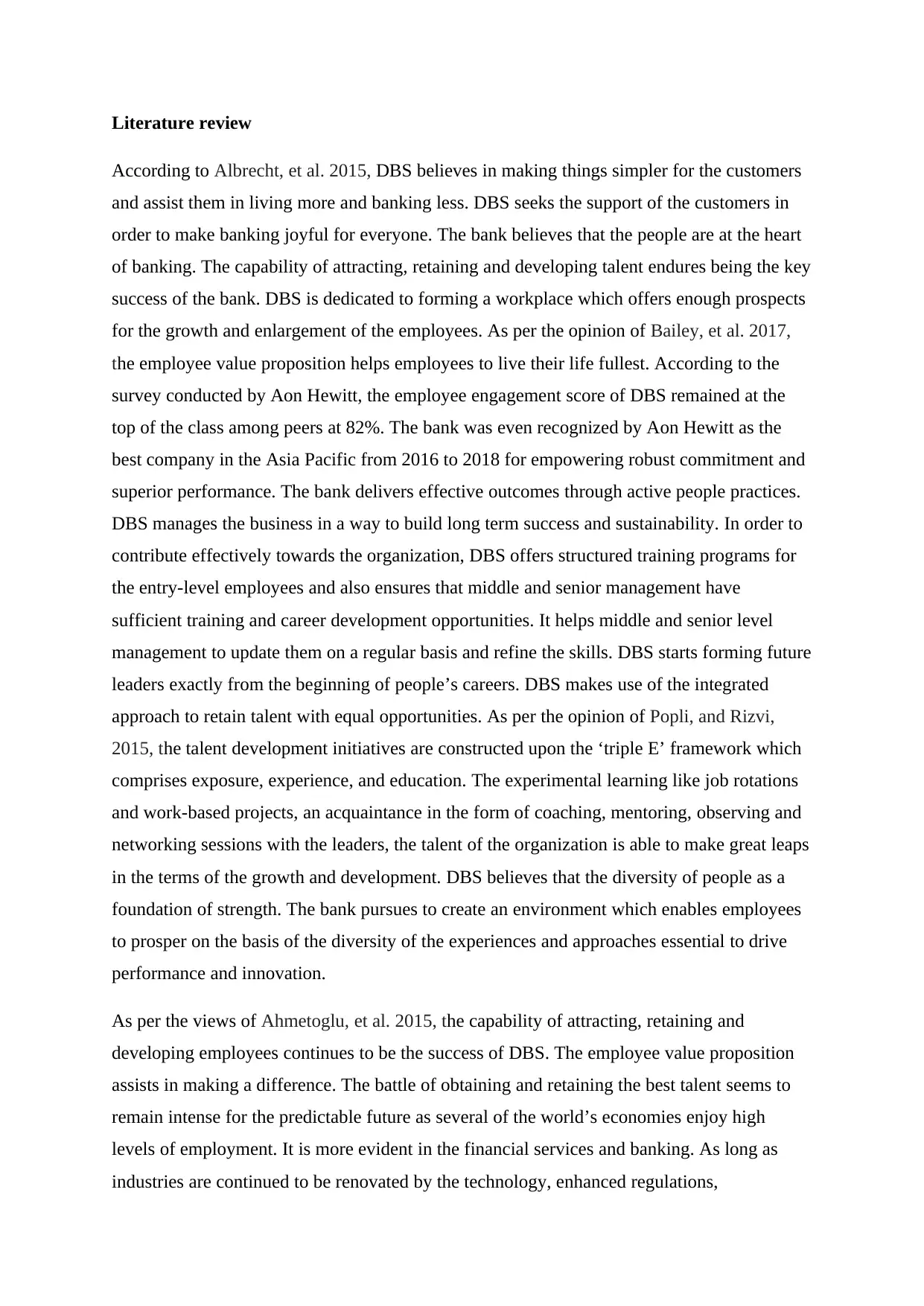
Literature review
According to Albrecht, et al. 2015, DBS believes in making things simpler for the customers
and assist them in living more and banking less. DBS seeks the support of the customers in
order to make banking joyful for everyone. The bank believes that the people are at the heart
of banking. The capability of attracting, retaining and developing talent endures being the key
success of the bank. DBS is dedicated to forming a workplace which offers enough prospects
for the growth and enlargement of the employees. As per the opinion of Bailey, et al. 2017,
the employee value proposition helps employees to live their life fullest. According to the
survey conducted by Aon Hewitt, the employee engagement score of DBS remained at the
top of the class among peers at 82%. The bank was even recognized by Aon Hewitt as the
best company in the Asia Pacific from 2016 to 2018 for empowering robust commitment and
superior performance. The bank delivers effective outcomes through active people practices.
DBS manages the business in a way to build long term success and sustainability. In order to
contribute effectively towards the organization, DBS offers structured training programs for
the entry-level employees and also ensures that middle and senior management have
sufficient training and career development opportunities. It helps middle and senior level
management to update them on a regular basis and refine the skills. DBS starts forming future
leaders exactly from the beginning of people’s careers. DBS makes use of the integrated
approach to retain talent with equal opportunities. As per the opinion of Popli, and Rizvi,
2015, the talent development initiatives are constructed upon the ‘triple E’ framework which
comprises exposure, experience, and education. The experimental learning like job rotations
and work-based projects, an acquaintance in the form of coaching, mentoring, observing and
networking sessions with the leaders, the talent of the organization is able to make great leaps
in the terms of the growth and development. DBS believes that the diversity of people as a
foundation of strength. The bank pursues to create an environment which enables employees
to prosper on the basis of the diversity of the experiences and approaches essential to drive
performance and innovation.
As per the views of Ahmetoglu, et al. 2015, the capability of attracting, retaining and
developing employees continues to be the success of DBS. The employee value proposition
assists in making a difference. The battle of obtaining and retaining the best talent seems to
remain intense for the predictable future as several of the world’s economies enjoy high
levels of employment. It is more evident in the financial services and banking. As long as
industries are continued to be renovated by the technology, enhanced regulations,
According to Albrecht, et al. 2015, DBS believes in making things simpler for the customers
and assist them in living more and banking less. DBS seeks the support of the customers in
order to make banking joyful for everyone. The bank believes that the people are at the heart
of banking. The capability of attracting, retaining and developing talent endures being the key
success of the bank. DBS is dedicated to forming a workplace which offers enough prospects
for the growth and enlargement of the employees. As per the opinion of Bailey, et al. 2017,
the employee value proposition helps employees to live their life fullest. According to the
survey conducted by Aon Hewitt, the employee engagement score of DBS remained at the
top of the class among peers at 82%. The bank was even recognized by Aon Hewitt as the
best company in the Asia Pacific from 2016 to 2018 for empowering robust commitment and
superior performance. The bank delivers effective outcomes through active people practices.
DBS manages the business in a way to build long term success and sustainability. In order to
contribute effectively towards the organization, DBS offers structured training programs for
the entry-level employees and also ensures that middle and senior management have
sufficient training and career development opportunities. It helps middle and senior level
management to update them on a regular basis and refine the skills. DBS starts forming future
leaders exactly from the beginning of people’s careers. DBS makes use of the integrated
approach to retain talent with equal opportunities. As per the opinion of Popli, and Rizvi,
2015, the talent development initiatives are constructed upon the ‘triple E’ framework which
comprises exposure, experience, and education. The experimental learning like job rotations
and work-based projects, an acquaintance in the form of coaching, mentoring, observing and
networking sessions with the leaders, the talent of the organization is able to make great leaps
in the terms of the growth and development. DBS believes that the diversity of people as a
foundation of strength. The bank pursues to create an environment which enables employees
to prosper on the basis of the diversity of the experiences and approaches essential to drive
performance and innovation.
As per the views of Ahmetoglu, et al. 2015, the capability of attracting, retaining and
developing employees continues to be the success of DBS. The employee value proposition
assists in making a difference. The battle of obtaining and retaining the best talent seems to
remain intense for the predictable future as several of the world’s economies enjoy high
levels of employment. It is more evident in the financial services and banking. As long as
industries are continued to be renovated by the technology, enhanced regulations,
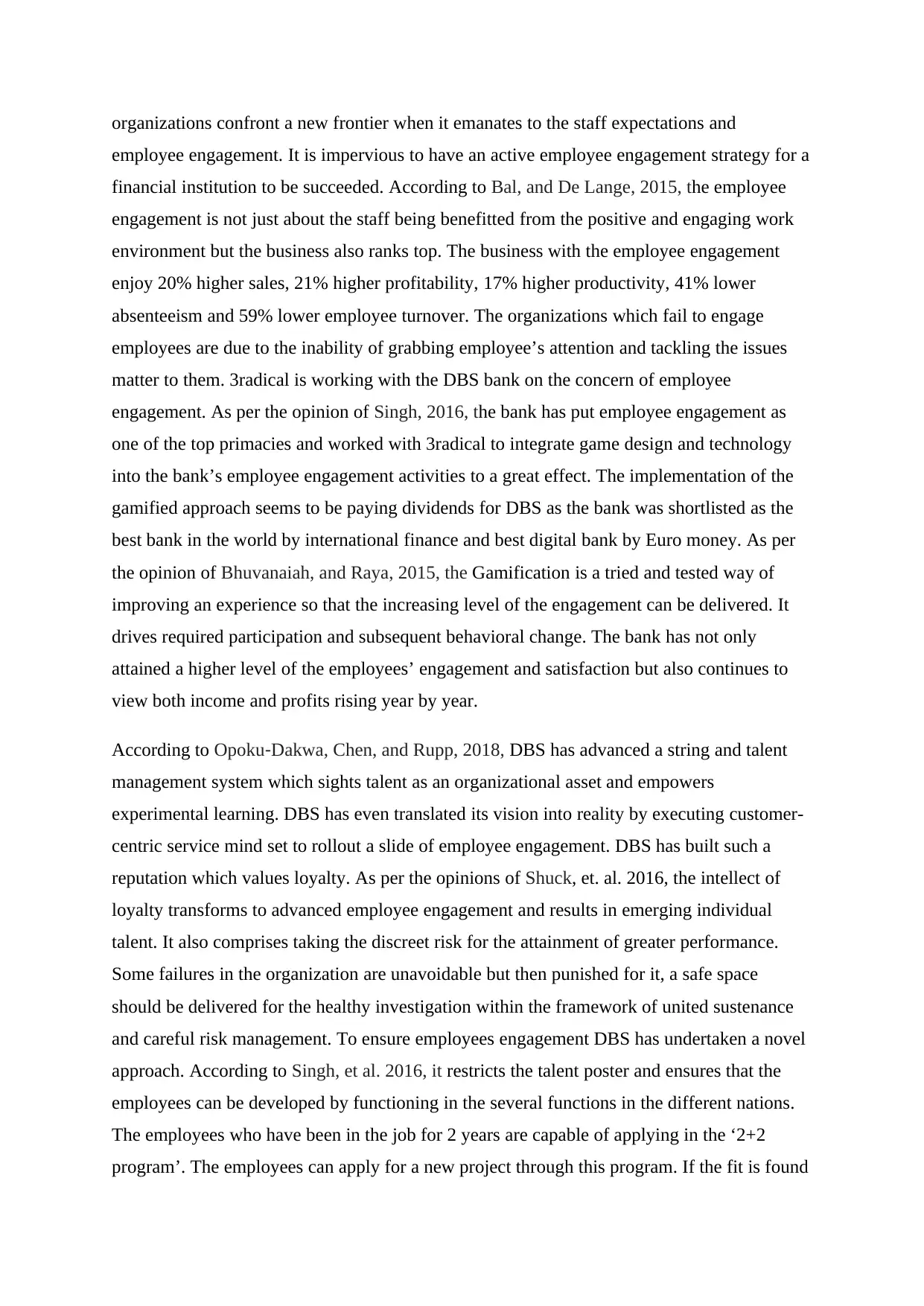
organizations confront a new frontier when it emanates to the staff expectations and
employee engagement. It is impervious to have an active employee engagement strategy for a
financial institution to be succeeded. According to Bal, and De Lange, 2015, the employee
engagement is not just about the staff being benefitted from the positive and engaging work
environment but the business also ranks top. The business with the employee engagement
enjoy 20% higher sales, 21% higher profitability, 17% higher productivity, 41% lower
absenteeism and 59% lower employee turnover. The organizations which fail to engage
employees are due to the inability of grabbing employee’s attention and tackling the issues
matter to them. 3radical is working with the DBS bank on the concern of employee
engagement. As per the opinion of Singh, 2016, the bank has put employee engagement as
one of the top primacies and worked with 3radical to integrate game design and technology
into the bank’s employee engagement activities to a great effect. The implementation of the
gamified approach seems to be paying dividends for DBS as the bank was shortlisted as the
best bank in the world by international finance and best digital bank by Euro money. As per
the opinion of Bhuvanaiah, and Raya, 2015, the Gamification is a tried and tested way of
improving an experience so that the increasing level of the engagement can be delivered. It
drives required participation and subsequent behavioral change. The bank has not only
attained a higher level of the employees’ engagement and satisfaction but also continues to
view both income and profits rising year by year.
According to Opoku‐Dakwa, Chen, and Rupp, 2018, DBS has advanced a string and talent
management system which sights talent as an organizational asset and empowers
experimental learning. DBS has even translated its vision into reality by executing customer-
centric service mind set to rollout a slide of employee engagement. DBS has built such a
reputation which values loyalty. As per the opinions of Shuck, et. al. 2016, the intellect of
loyalty transforms to advanced employee engagement and results in emerging individual
talent. It also comprises taking the discreet risk for the attainment of greater performance.
Some failures in the organization are unavoidable but then punished for it, a safe space
should be delivered for the healthy investigation within the framework of united sustenance
and careful risk management. To ensure employees engagement DBS has undertaken a novel
approach. According to Singh, et al. 2016, it restricts the talent poster and ensures that the
employees can be developed by functioning in the several functions in the different nations.
The employees who have been in the job for 2 years are capable of applying in the ‘2+2
program’. The employees can apply for a new project through this program. If the fit is found
employee engagement. It is impervious to have an active employee engagement strategy for a
financial institution to be succeeded. According to Bal, and De Lange, 2015, the employee
engagement is not just about the staff being benefitted from the positive and engaging work
environment but the business also ranks top. The business with the employee engagement
enjoy 20% higher sales, 21% higher profitability, 17% higher productivity, 41% lower
absenteeism and 59% lower employee turnover. The organizations which fail to engage
employees are due to the inability of grabbing employee’s attention and tackling the issues
matter to them. 3radical is working with the DBS bank on the concern of employee
engagement. As per the opinion of Singh, 2016, the bank has put employee engagement as
one of the top primacies and worked with 3radical to integrate game design and technology
into the bank’s employee engagement activities to a great effect. The implementation of the
gamified approach seems to be paying dividends for DBS as the bank was shortlisted as the
best bank in the world by international finance and best digital bank by Euro money. As per
the opinion of Bhuvanaiah, and Raya, 2015, the Gamification is a tried and tested way of
improving an experience so that the increasing level of the engagement can be delivered. It
drives required participation and subsequent behavioral change. The bank has not only
attained a higher level of the employees’ engagement and satisfaction but also continues to
view both income and profits rising year by year.
According to Opoku‐Dakwa, Chen, and Rupp, 2018, DBS has advanced a string and talent
management system which sights talent as an organizational asset and empowers
experimental learning. DBS has even translated its vision into reality by executing customer-
centric service mind set to rollout a slide of employee engagement. DBS has built such a
reputation which values loyalty. As per the opinions of Shuck, et. al. 2016, the intellect of
loyalty transforms to advanced employee engagement and results in emerging individual
talent. It also comprises taking the discreet risk for the attainment of greater performance.
Some failures in the organization are unavoidable but then punished for it, a safe space
should be delivered for the healthy investigation within the framework of united sustenance
and careful risk management. To ensure employees engagement DBS has undertaken a novel
approach. According to Singh, et al. 2016, it restricts the talent poster and ensures that the
employees can be developed by functioning in the several functions in the different nations.
The employees who have been in the job for 2 years are capable of applying in the ‘2+2
program’. The employees can apply for a new project through this program. If the fit is found
⊘ This is a preview!⊘
Do you want full access?
Subscribe today to unlock all pages.

Trusted by 1+ million students worldwide
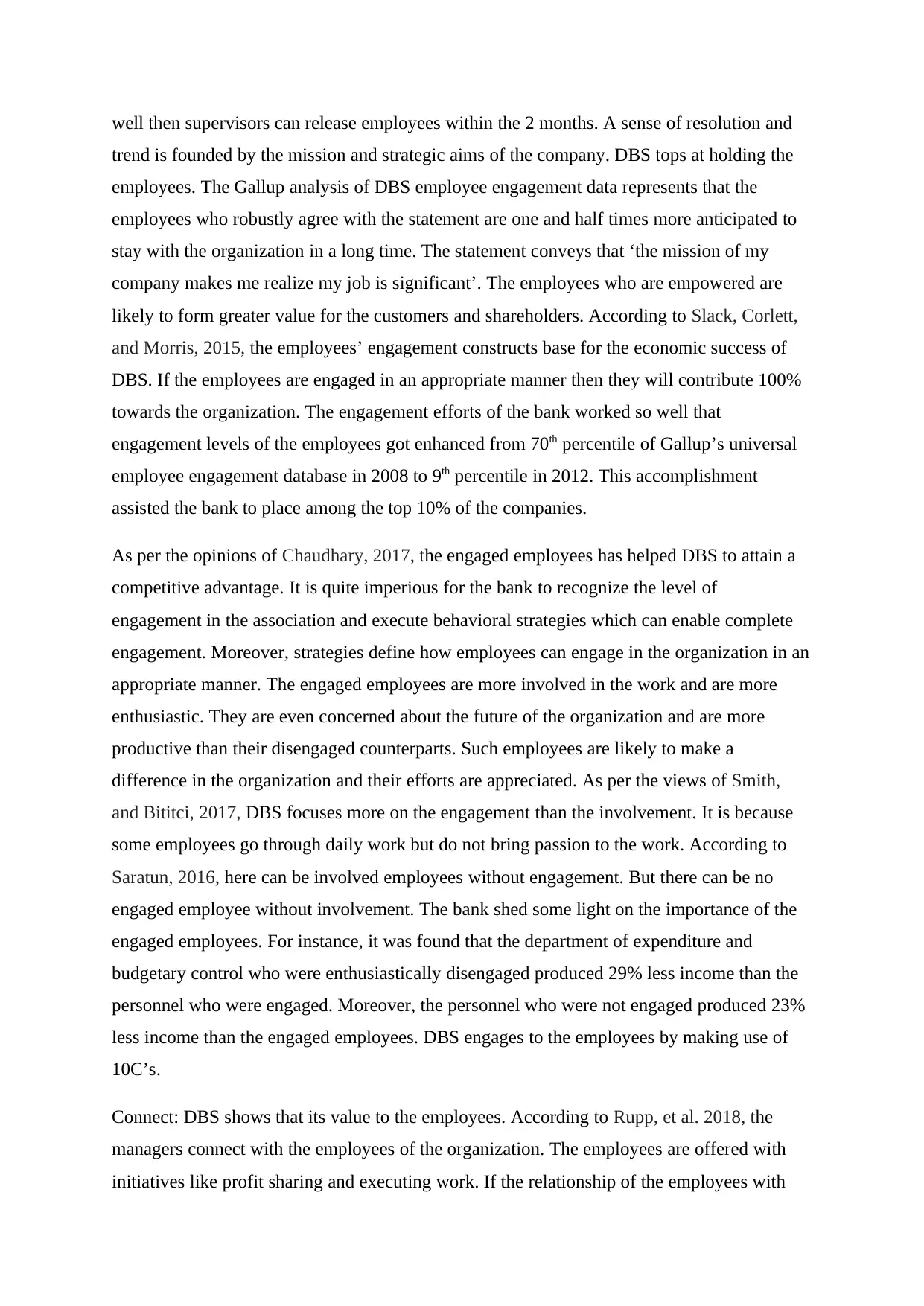
well then supervisors can release employees within the 2 months. A sense of resolution and
trend is founded by the mission and strategic aims of the company. DBS tops at holding the
employees. The Gallup analysis of DBS employee engagement data represents that the
employees who robustly agree with the statement are one and half times more anticipated to
stay with the organization in a long time. The statement conveys that ‘the mission of my
company makes me realize my job is significant’. The employees who are empowered are
likely to form greater value for the customers and shareholders. According to Slack, Corlett,
and Morris, 2015, the employees’ engagement constructs base for the economic success of
DBS. If the employees are engaged in an appropriate manner then they will contribute 100%
towards the organization. The engagement efforts of the bank worked so well that
engagement levels of the employees got enhanced from 70th percentile of Gallup’s universal
employee engagement database in 2008 to 9th percentile in 2012. This accomplishment
assisted the bank to place among the top 10% of the companies.
As per the opinions of Chaudhary, 2017, the engaged employees has helped DBS to attain a
competitive advantage. It is quite imperious for the bank to recognize the level of
engagement in the association and execute behavioral strategies which can enable complete
engagement. Moreover, strategies define how employees can engage in the organization in an
appropriate manner. The engaged employees are more involved in the work and are more
enthusiastic. They are even concerned about the future of the organization and are more
productive than their disengaged counterparts. Such employees are likely to make a
difference in the organization and their efforts are appreciated. As per the views of Smith,
and Bititci, 2017, DBS focuses more on the engagement than the involvement. It is because
some employees go through daily work but do not bring passion to the work. According to
Saratun, 2016, here can be involved employees without engagement. But there can be no
engaged employee without involvement. The bank shed some light on the importance of the
engaged employees. For instance, it was found that the department of expenditure and
budgetary control who were enthusiastically disengaged produced 29% less income than the
personnel who were engaged. Moreover, the personnel who were not engaged produced 23%
less income than the engaged employees. DBS engages to the employees by making use of
10C’s.
Connect: DBS shows that its value to the employees. According to Rupp, et al. 2018, the
managers connect with the employees of the organization. The employees are offered with
initiatives like profit sharing and executing work. If the relationship of the employees with
trend is founded by the mission and strategic aims of the company. DBS tops at holding the
employees. The Gallup analysis of DBS employee engagement data represents that the
employees who robustly agree with the statement are one and half times more anticipated to
stay with the organization in a long time. The statement conveys that ‘the mission of my
company makes me realize my job is significant’. The employees who are empowered are
likely to form greater value for the customers and shareholders. According to Slack, Corlett,
and Morris, 2015, the employees’ engagement constructs base for the economic success of
DBS. If the employees are engaged in an appropriate manner then they will contribute 100%
towards the organization. The engagement efforts of the bank worked so well that
engagement levels of the employees got enhanced from 70th percentile of Gallup’s universal
employee engagement database in 2008 to 9th percentile in 2012. This accomplishment
assisted the bank to place among the top 10% of the companies.
As per the opinions of Chaudhary, 2017, the engaged employees has helped DBS to attain a
competitive advantage. It is quite imperious for the bank to recognize the level of
engagement in the association and execute behavioral strategies which can enable complete
engagement. Moreover, strategies define how employees can engage in the organization in an
appropriate manner. The engaged employees are more involved in the work and are more
enthusiastic. They are even concerned about the future of the organization and are more
productive than their disengaged counterparts. Such employees are likely to make a
difference in the organization and their efforts are appreciated. As per the views of Smith,
and Bititci, 2017, DBS focuses more on the engagement than the involvement. It is because
some employees go through daily work but do not bring passion to the work. According to
Saratun, 2016, here can be involved employees without engagement. But there can be no
engaged employee without involvement. The bank shed some light on the importance of the
engaged employees. For instance, it was found that the department of expenditure and
budgetary control who were enthusiastically disengaged produced 29% less income than the
personnel who were engaged. Moreover, the personnel who were not engaged produced 23%
less income than the engaged employees. DBS engages to the employees by making use of
10C’s.
Connect: DBS shows that its value to the employees. According to Rupp, et al. 2018, the
managers connect with the employees of the organization. The employees are offered with
initiatives like profit sharing and executing work. If the relationship of the employees with
Paraphrase This Document
Need a fresh take? Get an instant paraphrase of this document with our AI Paraphraser
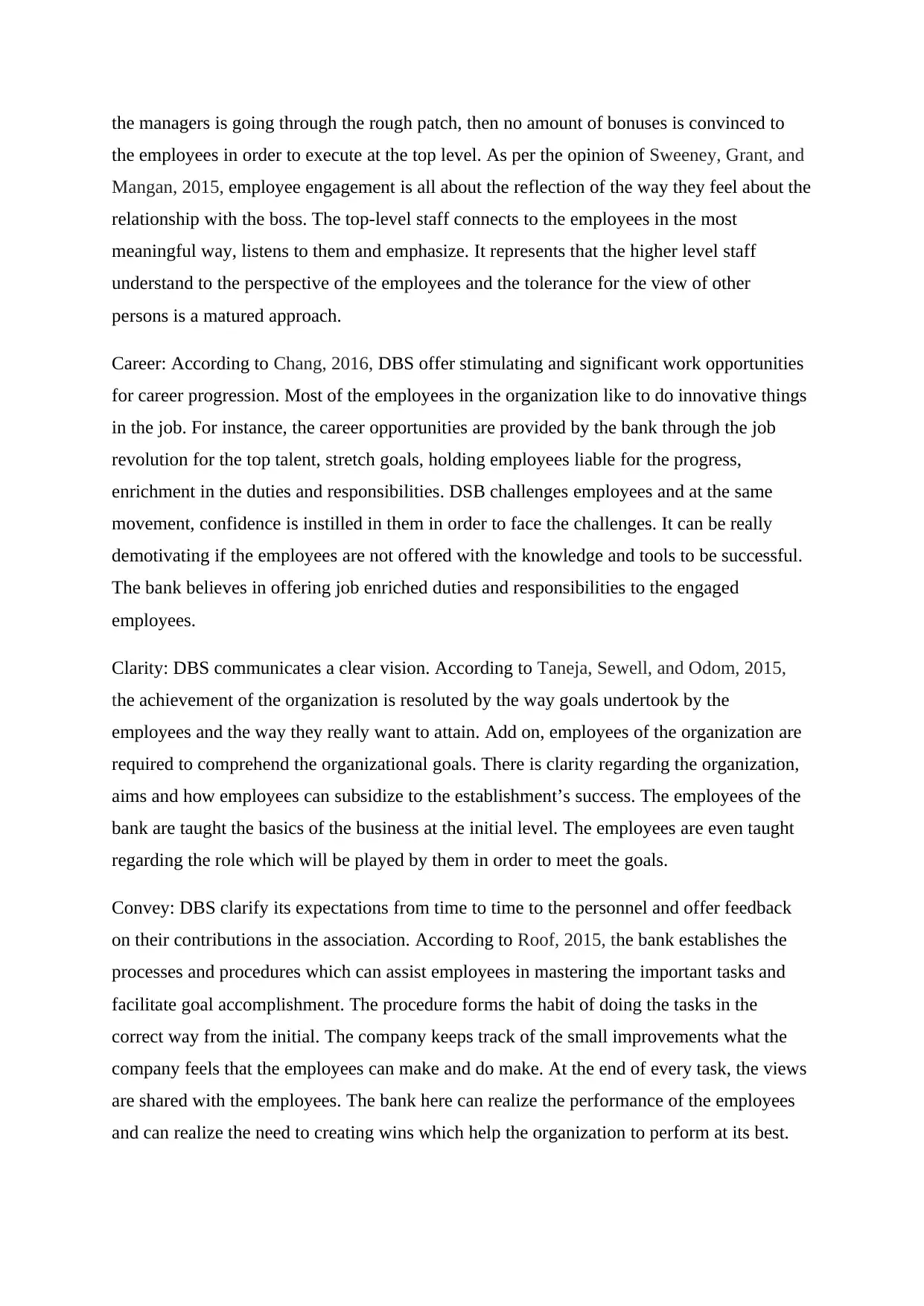
the managers is going through the rough patch, then no amount of bonuses is convinced to
the employees in order to execute at the top level. As per the opinion of Sweeney, Grant, and
Mangan, 2015, employee engagement is all about the reflection of the way they feel about the
relationship with the boss. The top-level staff connects to the employees in the most
meaningful way, listens to them and emphasize. It represents that the higher level staff
understand to the perspective of the employees and the tolerance for the view of other
persons is a matured approach.
Career: According to Chang, 2016, DBS offer stimulating and significant work opportunities
for career progression. Most of the employees in the organization like to do innovative things
in the job. For instance, the career opportunities are provided by the bank through the job
revolution for the top talent, stretch goals, holding employees liable for the progress,
enrichment in the duties and responsibilities. DSB challenges employees and at the same
movement, confidence is instilled in them in order to face the challenges. It can be really
demotivating if the employees are not offered with the knowledge and tools to be successful.
The bank believes in offering job enriched duties and responsibilities to the engaged
employees.
Clarity: DBS communicates a clear vision. According to Taneja, Sewell, and Odom, 2015,
the achievement of the organization is resoluted by the way goals undertook by the
employees and the way they really want to attain. Add on, employees of the organization are
required to comprehend the organizational goals. There is clarity regarding the organization,
aims and how employees can subsidize to the establishment’s success. The employees of the
bank are taught the basics of the business at the initial level. The employees are even taught
regarding the role which will be played by them in order to meet the goals.
Convey: DBS clarify its expectations from time to time to the personnel and offer feedback
on their contributions in the association. According to Roof, 2015, the bank establishes the
processes and procedures which can assist employees in mastering the important tasks and
facilitate goal accomplishment. The procedure forms the habit of doing the tasks in the
correct way from the initial. The company keeps track of the small improvements what the
company feels that the employees can make and do make. At the end of every task, the views
are shared with the employees. The bank here can realize the performance of the employees
and can realize the need to creating wins which help the organization to perform at its best.
the employees in order to execute at the top level. As per the opinion of Sweeney, Grant, and
Mangan, 2015, employee engagement is all about the reflection of the way they feel about the
relationship with the boss. The top-level staff connects to the employees in the most
meaningful way, listens to them and emphasize. It represents that the higher level staff
understand to the perspective of the employees and the tolerance for the view of other
persons is a matured approach.
Career: According to Chang, 2016, DBS offer stimulating and significant work opportunities
for career progression. Most of the employees in the organization like to do innovative things
in the job. For instance, the career opportunities are provided by the bank through the job
revolution for the top talent, stretch goals, holding employees liable for the progress,
enrichment in the duties and responsibilities. DSB challenges employees and at the same
movement, confidence is instilled in them in order to face the challenges. It can be really
demotivating if the employees are not offered with the knowledge and tools to be successful.
The bank believes in offering job enriched duties and responsibilities to the engaged
employees.
Clarity: DBS communicates a clear vision. According to Taneja, Sewell, and Odom, 2015,
the achievement of the organization is resoluted by the way goals undertook by the
employees and the way they really want to attain. Add on, employees of the organization are
required to comprehend the organizational goals. There is clarity regarding the organization,
aims and how employees can subsidize to the establishment’s success. The employees of the
bank are taught the basics of the business at the initial level. The employees are even taught
regarding the role which will be played by them in order to meet the goals.
Convey: DBS clarify its expectations from time to time to the personnel and offer feedback
on their contributions in the association. According to Roof, 2015, the bank establishes the
processes and procedures which can assist employees in mastering the important tasks and
facilitate goal accomplishment. The procedure forms the habit of doing the tasks in the
correct way from the initial. The company keeps track of the small improvements what the
company feels that the employees can make and do make. At the end of every task, the views
are shared with the employees. The bank here can realize the performance of the employees
and can realize the need to creating wins which help the organization to perform at its best.
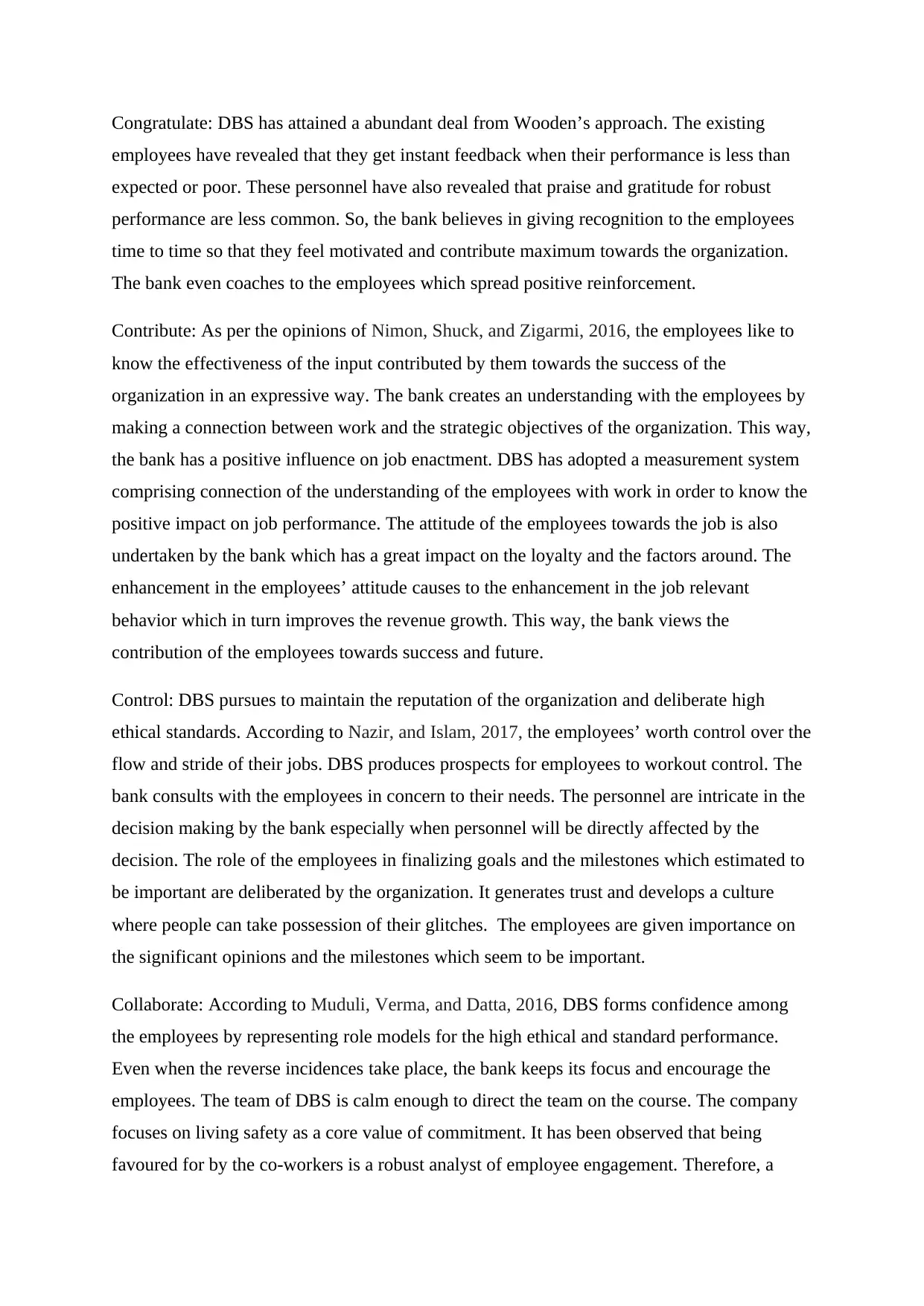
Congratulate: DBS has attained a abundant deal from Wooden’s approach. The existing
employees have revealed that they get instant feedback when their performance is less than
expected or poor. These personnel have also revealed that praise and gratitude for robust
performance are less common. So, the bank believes in giving recognition to the employees
time to time so that they feel motivated and contribute maximum towards the organization.
The bank even coaches to the employees which spread positive reinforcement.
Contribute: As per the opinions of Nimon, Shuck, and Zigarmi, 2016, the employees like to
know the effectiveness of the input contributed by them towards the success of the
organization in an expressive way. The bank creates an understanding with the employees by
making a connection between work and the strategic objectives of the organization. This way,
the bank has a positive influence on job enactment. DBS has adopted a measurement system
comprising connection of the understanding of the employees with work in order to know the
positive impact on job performance. The attitude of the employees towards the job is also
undertaken by the bank which has a great impact on the loyalty and the factors around. The
enhancement in the employees’ attitude causes to the enhancement in the job relevant
behavior which in turn improves the revenue growth. This way, the bank views the
contribution of the employees towards success and future.
Control: DBS pursues to maintain the reputation of the organization and deliberate high
ethical standards. According to Nazir, and Islam, 2017, the employees’ worth control over the
flow and stride of their jobs. DBS produces prospects for employees to workout control. The
bank consults with the employees in concern to their needs. The personnel are intricate in the
decision making by the bank especially when personnel will be directly affected by the
decision. The role of the employees in finalizing goals and the milestones which estimated to
be important are deliberated by the organization. It generates trust and develops a culture
where people can take possession of their glitches. The employees are given importance on
the significant opinions and the milestones which seem to be important.
Collaborate: According to Muduli, Verma, and Datta, 2016, DBS forms confidence among
the employees by representing role models for the high ethical and standard performance.
Even when the reverse incidences take place, the bank keeps its focus and encourage the
employees. The team of DBS is calm enough to direct the team on the course. The company
focuses on living safety as a core value of commitment. It has been observed that being
favoured for by the co-workers is a robust analyst of employee engagement. Therefore, a
employees have revealed that they get instant feedback when their performance is less than
expected or poor. These personnel have also revealed that praise and gratitude for robust
performance are less common. So, the bank believes in giving recognition to the employees
time to time so that they feel motivated and contribute maximum towards the organization.
The bank even coaches to the employees which spread positive reinforcement.
Contribute: As per the opinions of Nimon, Shuck, and Zigarmi, 2016, the employees like to
know the effectiveness of the input contributed by them towards the success of the
organization in an expressive way. The bank creates an understanding with the employees by
making a connection between work and the strategic objectives of the organization. This way,
the bank has a positive influence on job enactment. DBS has adopted a measurement system
comprising connection of the understanding of the employees with work in order to know the
positive impact on job performance. The attitude of the employees towards the job is also
undertaken by the bank which has a great impact on the loyalty and the factors around. The
enhancement in the employees’ attitude causes to the enhancement in the job relevant
behavior which in turn improves the revenue growth. This way, the bank views the
contribution of the employees towards success and future.
Control: DBS pursues to maintain the reputation of the organization and deliberate high
ethical standards. According to Nazir, and Islam, 2017, the employees’ worth control over the
flow and stride of their jobs. DBS produces prospects for employees to workout control. The
bank consults with the employees in concern to their needs. The personnel are intricate in the
decision making by the bank especially when personnel will be directly affected by the
decision. The role of the employees in finalizing goals and the milestones which estimated to
be important are deliberated by the organization. It generates trust and develops a culture
where people can take possession of their glitches. The employees are given importance on
the significant opinions and the milestones which seem to be important.
Collaborate: According to Muduli, Verma, and Datta, 2016, DBS forms confidence among
the employees by representing role models for the high ethical and standard performance.
Even when the reverse incidences take place, the bank keeps its focus and encourage the
employees. The team of DBS is calm enough to direct the team on the course. The company
focuses on living safety as a core value of commitment. It has been observed that being
favoured for by the co-workers is a robust analyst of employee engagement. Therefore, a
⊘ This is a preview!⊘
Do you want full access?
Subscribe today to unlock all pages.

Trusted by 1+ million students worldwide
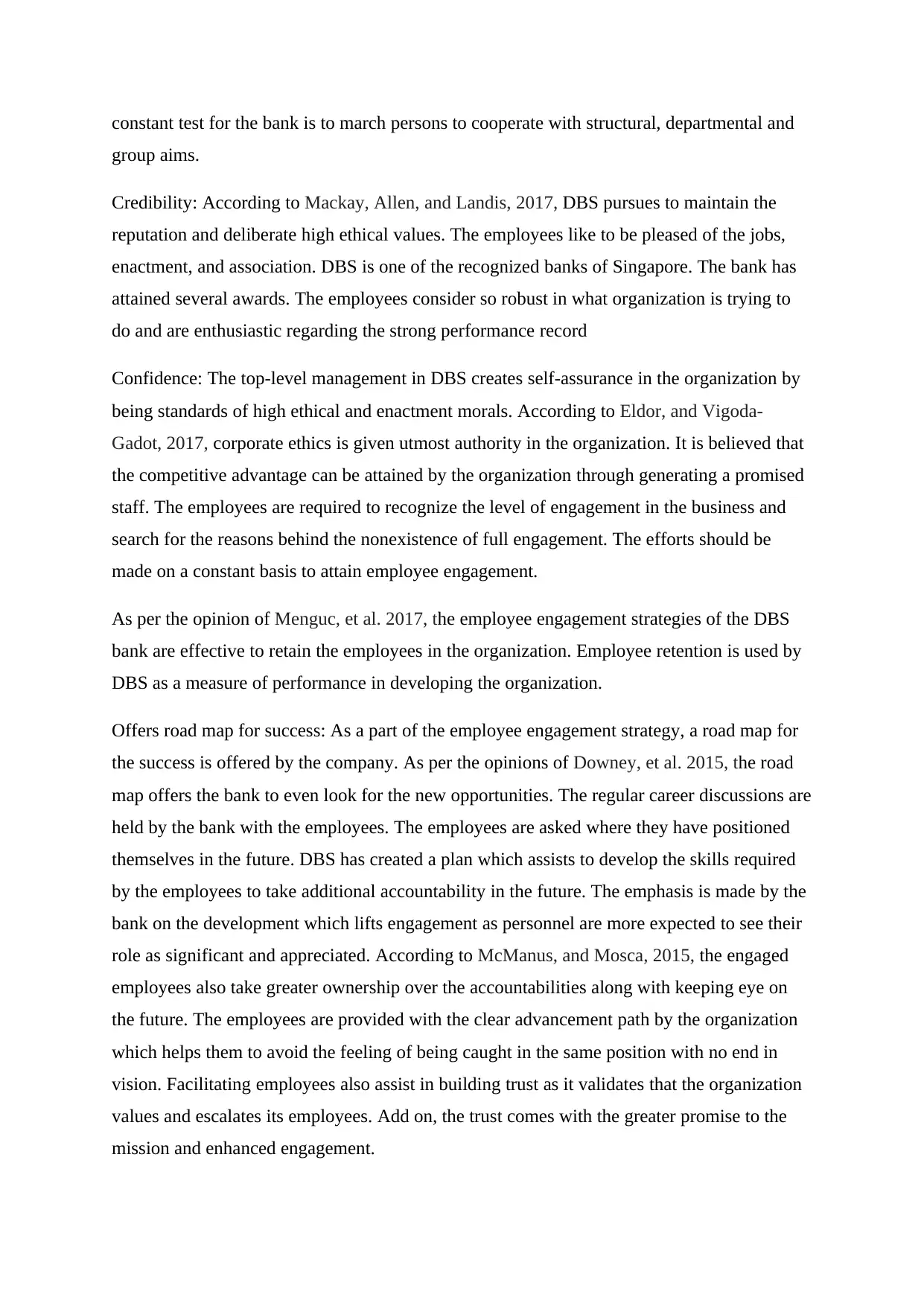
constant test for the bank is to march persons to cooperate with structural, departmental and
group aims.
Credibility: According to Mackay, Allen, and Landis, 2017, DBS pursues to maintain the
reputation and deliberate high ethical values. The employees like to be pleased of the jobs,
enactment, and association. DBS is one of the recognized banks of Singapore. The bank has
attained several awards. The employees consider so robust in what organization is trying to
do and are enthusiastic regarding the strong performance record
Confidence: The top-level management in DBS creates self-assurance in the organization by
being standards of high ethical and enactment morals. According to Eldor, and Vigoda-
Gadot, 2017, corporate ethics is given utmost authority in the organization. It is believed that
the competitive advantage can be attained by the organization through generating a promised
staff. The employees are required to recognize the level of engagement in the business and
search for the reasons behind the nonexistence of full engagement. The efforts should be
made on a constant basis to attain employee engagement.
As per the opinion of Menguc, et al. 2017, the employee engagement strategies of the DBS
bank are effective to retain the employees in the organization. Employee retention is used by
DBS as a measure of performance in developing the organization.
Offers road map for success: As a part of the employee engagement strategy, a road map for
the success is offered by the company. As per the opinions of Downey, et al. 2015, the road
map offers the bank to even look for the new opportunities. The regular career discussions are
held by the bank with the employees. The employees are asked where they have positioned
themselves in the future. DBS has created a plan which assists to develop the skills required
by the employees to take additional accountability in the future. The emphasis is made by the
bank on the development which lifts engagement as personnel are more expected to see their
role as significant and appreciated. According to McManus, and Mosca, 2015, the engaged
employees also take greater ownership over the accountabilities along with keeping eye on
the future. The employees are provided with the clear advancement path by the organization
which helps them to avoid the feeling of being caught in the same position with no end in
vision. Facilitating employees also assist in building trust as it validates that the organization
values and escalates its employees. Add on, the trust comes with the greater promise to the
mission and enhanced engagement.
group aims.
Credibility: According to Mackay, Allen, and Landis, 2017, DBS pursues to maintain the
reputation and deliberate high ethical values. The employees like to be pleased of the jobs,
enactment, and association. DBS is one of the recognized banks of Singapore. The bank has
attained several awards. The employees consider so robust in what organization is trying to
do and are enthusiastic regarding the strong performance record
Confidence: The top-level management in DBS creates self-assurance in the organization by
being standards of high ethical and enactment morals. According to Eldor, and Vigoda-
Gadot, 2017, corporate ethics is given utmost authority in the organization. It is believed that
the competitive advantage can be attained by the organization through generating a promised
staff. The employees are required to recognize the level of engagement in the business and
search for the reasons behind the nonexistence of full engagement. The efforts should be
made on a constant basis to attain employee engagement.
As per the opinion of Menguc, et al. 2017, the employee engagement strategies of the DBS
bank are effective to retain the employees in the organization. Employee retention is used by
DBS as a measure of performance in developing the organization.
Offers road map for success: As a part of the employee engagement strategy, a road map for
the success is offered by the company. As per the opinions of Downey, et al. 2015, the road
map offers the bank to even look for the new opportunities. The regular career discussions are
held by the bank with the employees. The employees are asked where they have positioned
themselves in the future. DBS has created a plan which assists to develop the skills required
by the employees to take additional accountability in the future. The emphasis is made by the
bank on the development which lifts engagement as personnel are more expected to see their
role as significant and appreciated. According to McManus, and Mosca, 2015, the engaged
employees also take greater ownership over the accountabilities along with keeping eye on
the future. The employees are provided with the clear advancement path by the organization
which helps them to avoid the feeling of being caught in the same position with no end in
vision. Facilitating employees also assist in building trust as it validates that the organization
values and escalates its employees. Add on, the trust comes with the greater promise to the
mission and enhanced engagement.
Paraphrase This Document
Need a fresh take? Get an instant paraphrase of this document with our AI Paraphraser
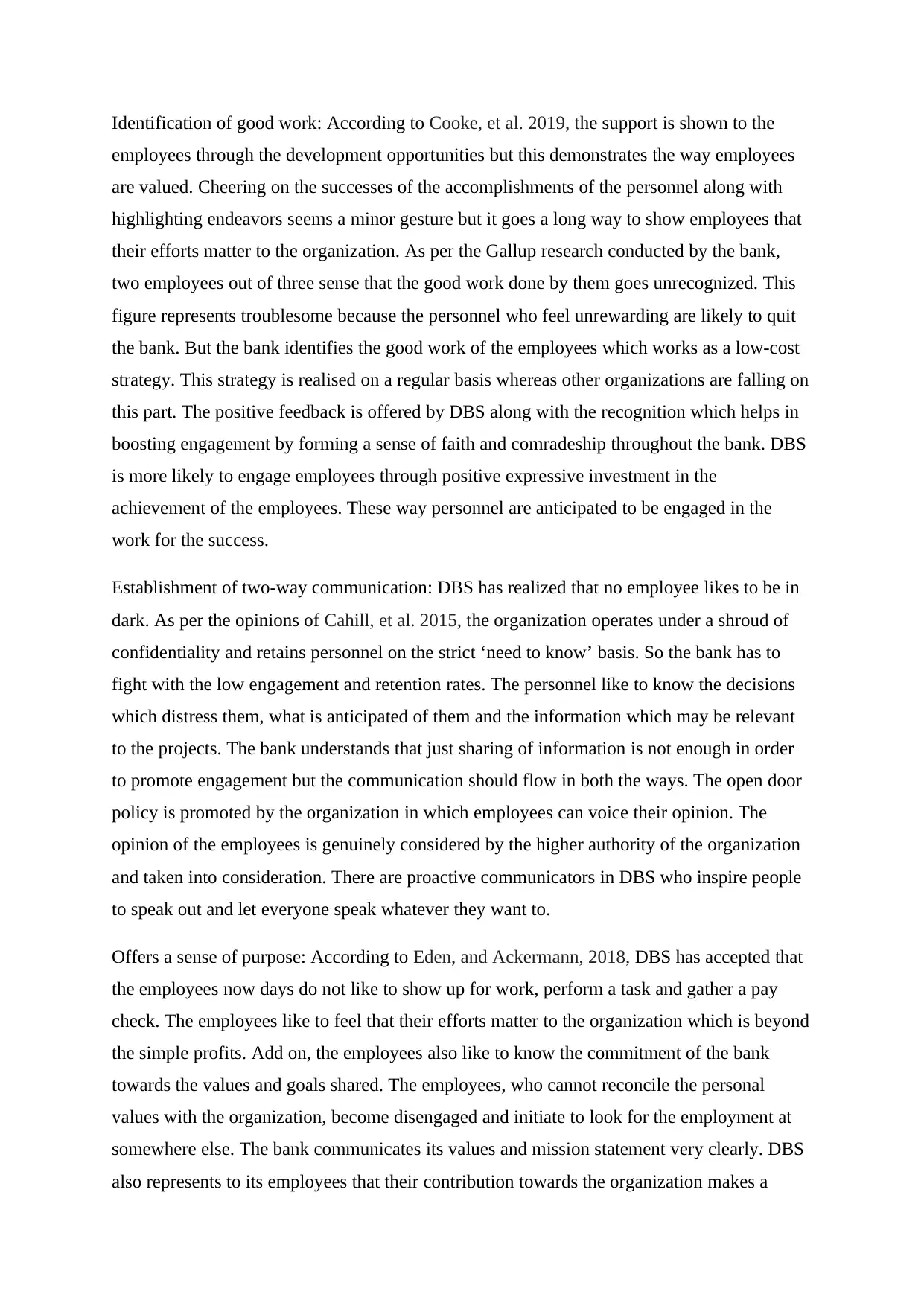
Identification of good work: According to Cooke, et al. 2019, the support is shown to the
employees through the development opportunities but this demonstrates the way employees
are valued. Cheering on the successes of the accomplishments of the personnel along with
highlighting endeavors seems a minor gesture but it goes a long way to show employees that
their efforts matter to the organization. As per the Gallup research conducted by the bank,
two employees out of three sense that the good work done by them goes unrecognized. This
figure represents troublesome because the personnel who feel unrewarding are likely to quit
the bank. But the bank identifies the good work of the employees which works as a low-cost
strategy. This strategy is realised on a regular basis whereas other organizations are falling on
this part. The positive feedback is offered by DBS along with the recognition which helps in
boosting engagement by forming a sense of faith and comradeship throughout the bank. DBS
is more likely to engage employees through positive expressive investment in the
achievement of the employees. These way personnel are anticipated to be engaged in the
work for the success.
Establishment of two-way communication: DBS has realized that no employee likes to be in
dark. As per the opinions of Cahill, et al. 2015, the organization operates under a shroud of
confidentiality and retains personnel on the strict ‘need to know’ basis. So the bank has to
fight with the low engagement and retention rates. The personnel like to know the decisions
which distress them, what is anticipated of them and the information which may be relevant
to the projects. The bank understands that just sharing of information is not enough in order
to promote engagement but the communication should flow in both the ways. The open door
policy is promoted by the organization in which employees can voice their opinion. The
opinion of the employees is genuinely considered by the higher authority of the organization
and taken into consideration. There are proactive communicators in DBS who inspire people
to speak out and let everyone speak whatever they want to.
Offers a sense of purpose: According to Eden, and Ackermann, 2018, DBS has accepted that
the employees now days do not like to show up for work, perform a task and gather a pay
check. The employees like to feel that their efforts matter to the organization which is beyond
the simple profits. Add on, the employees also like to know the commitment of the bank
towards the values and goals shared. The employees, who cannot reconcile the personal
values with the organization, become disengaged and initiate to look for the employment at
somewhere else. The bank communicates its values and mission statement very clearly. DBS
also represents to its employees that their contribution towards the organization makes a
employees through the development opportunities but this demonstrates the way employees
are valued. Cheering on the successes of the accomplishments of the personnel along with
highlighting endeavors seems a minor gesture but it goes a long way to show employees that
their efforts matter to the organization. As per the Gallup research conducted by the bank,
two employees out of three sense that the good work done by them goes unrecognized. This
figure represents troublesome because the personnel who feel unrewarding are likely to quit
the bank. But the bank identifies the good work of the employees which works as a low-cost
strategy. This strategy is realised on a regular basis whereas other organizations are falling on
this part. The positive feedback is offered by DBS along with the recognition which helps in
boosting engagement by forming a sense of faith and comradeship throughout the bank. DBS
is more likely to engage employees through positive expressive investment in the
achievement of the employees. These way personnel are anticipated to be engaged in the
work for the success.
Establishment of two-way communication: DBS has realized that no employee likes to be in
dark. As per the opinions of Cahill, et al. 2015, the organization operates under a shroud of
confidentiality and retains personnel on the strict ‘need to know’ basis. So the bank has to
fight with the low engagement and retention rates. The personnel like to know the decisions
which distress them, what is anticipated of them and the information which may be relevant
to the projects. The bank understands that just sharing of information is not enough in order
to promote engagement but the communication should flow in both the ways. The open door
policy is promoted by the organization in which employees can voice their opinion. The
opinion of the employees is genuinely considered by the higher authority of the organization
and taken into consideration. There are proactive communicators in DBS who inspire people
to speak out and let everyone speak whatever they want to.
Offers a sense of purpose: According to Eden, and Ackermann, 2018, DBS has accepted that
the employees now days do not like to show up for work, perform a task and gather a pay
check. The employees like to feel that their efforts matter to the organization which is beyond
the simple profits. Add on, the employees also like to know the commitment of the bank
towards the values and goals shared. The employees, who cannot reconcile the personal
values with the organization, become disengaged and initiate to look for the employment at
somewhere else. The bank communicates its values and mission statement very clearly. DBS
also represents to its employees that their contribution towards the organization makes a
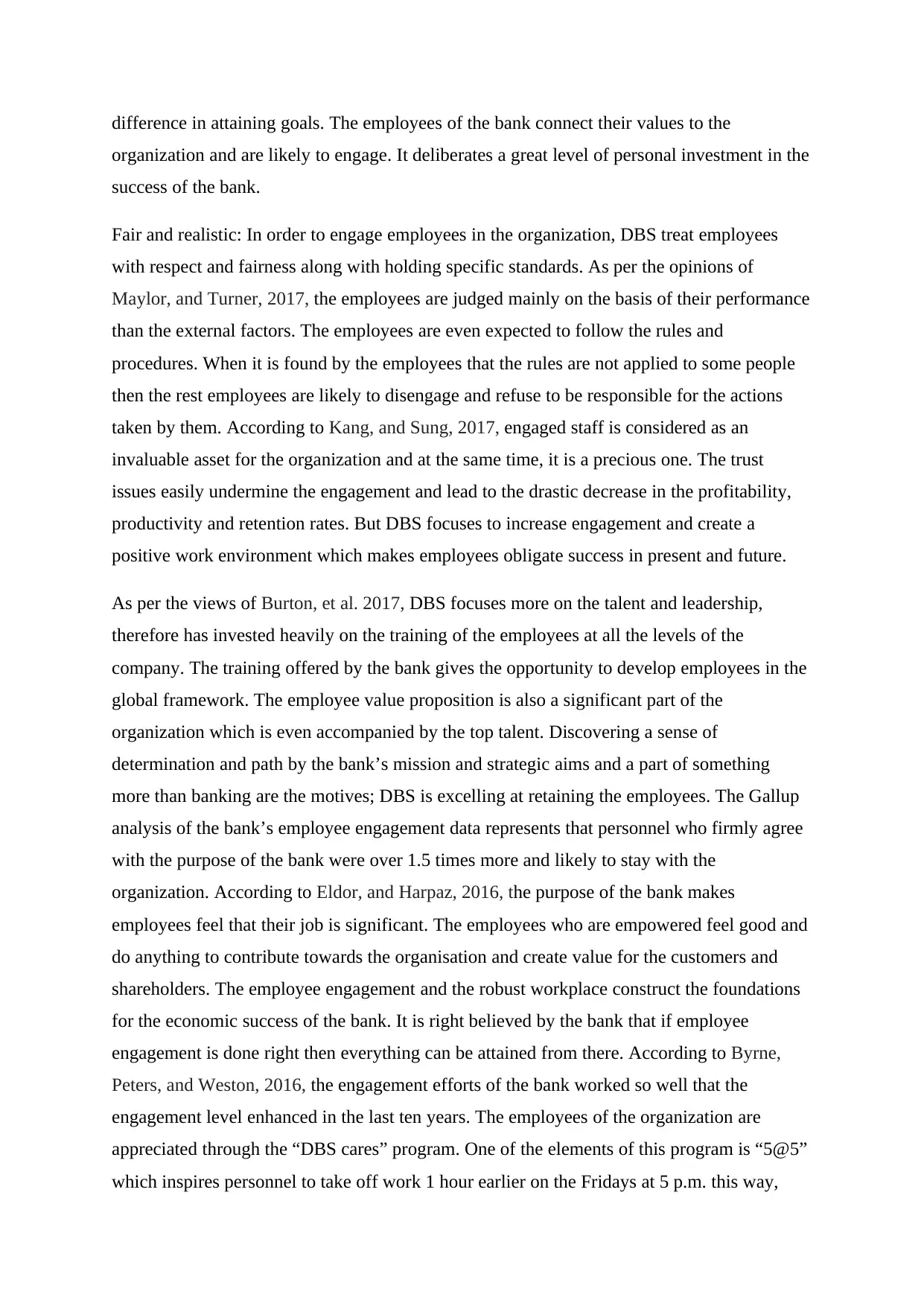
difference in attaining goals. The employees of the bank connect their values to the
organization and are likely to engage. It deliberates a great level of personal investment in the
success of the bank.
Fair and realistic: In order to engage employees in the organization, DBS treat employees
with respect and fairness along with holding specific standards. As per the opinions of
Maylor, and Turner, 2017, the employees are judged mainly on the basis of their performance
than the external factors. The employees are even expected to follow the rules and
procedures. When it is found by the employees that the rules are not applied to some people
then the rest employees are likely to disengage and refuse to be responsible for the actions
taken by them. According to Kang, and Sung, 2017, engaged staff is considered as an
invaluable asset for the organization and at the same time, it is a precious one. The trust
issues easily undermine the engagement and lead to the drastic decrease in the profitability,
productivity and retention rates. But DBS focuses to increase engagement and create a
positive work environment which makes employees obligate success in present and future.
As per the views of Burton, et al. 2017, DBS focuses more on the talent and leadership,
therefore has invested heavily on the training of the employees at all the levels of the
company. The training offered by the bank gives the opportunity to develop employees in the
global framework. The employee value proposition is also a significant part of the
organization which is even accompanied by the top talent. Discovering a sense of
determination and path by the bank’s mission and strategic aims and a part of something
more than banking are the motives; DBS is excelling at retaining the employees. The Gallup
analysis of the bank’s employee engagement data represents that personnel who firmly agree
with the purpose of the bank were over 1.5 times more and likely to stay with the
organization. According to Eldor, and Harpaz, 2016, the purpose of the bank makes
employees feel that their job is significant. The employees who are empowered feel good and
do anything to contribute towards the organisation and create value for the customers and
shareholders. The employee engagement and the robust workplace construct the foundations
for the economic success of the bank. It is right believed by the bank that if employee
engagement is done right then everything can be attained from there. According to Byrne,
Peters, and Weston, 2016, the engagement efforts of the bank worked so well that the
engagement level enhanced in the last ten years. The employees of the organization are
appreciated through the “DBS cares” program. One of the elements of this program is “5@5”
which inspires personnel to take off work 1 hour earlier on the Fridays at 5 p.m. this way,
organization and are likely to engage. It deliberates a great level of personal investment in the
success of the bank.
Fair and realistic: In order to engage employees in the organization, DBS treat employees
with respect and fairness along with holding specific standards. As per the opinions of
Maylor, and Turner, 2017, the employees are judged mainly on the basis of their performance
than the external factors. The employees are even expected to follow the rules and
procedures. When it is found by the employees that the rules are not applied to some people
then the rest employees are likely to disengage and refuse to be responsible for the actions
taken by them. According to Kang, and Sung, 2017, engaged staff is considered as an
invaluable asset for the organization and at the same time, it is a precious one. The trust
issues easily undermine the engagement and lead to the drastic decrease in the profitability,
productivity and retention rates. But DBS focuses to increase engagement and create a
positive work environment which makes employees obligate success in present and future.
As per the views of Burton, et al. 2017, DBS focuses more on the talent and leadership,
therefore has invested heavily on the training of the employees at all the levels of the
company. The training offered by the bank gives the opportunity to develop employees in the
global framework. The employee value proposition is also a significant part of the
organization which is even accompanied by the top talent. Discovering a sense of
determination and path by the bank’s mission and strategic aims and a part of something
more than banking are the motives; DBS is excelling at retaining the employees. The Gallup
analysis of the bank’s employee engagement data represents that personnel who firmly agree
with the purpose of the bank were over 1.5 times more and likely to stay with the
organization. According to Eldor, and Harpaz, 2016, the purpose of the bank makes
employees feel that their job is significant. The employees who are empowered feel good and
do anything to contribute towards the organisation and create value for the customers and
shareholders. The employee engagement and the robust workplace construct the foundations
for the economic success of the bank. It is right believed by the bank that if employee
engagement is done right then everything can be attained from there. According to Byrne,
Peters, and Weston, 2016, the engagement efforts of the bank worked so well that the
engagement level enhanced in the last ten years. The employees of the organization are
appreciated through the “DBS cares” program. One of the elements of this program is “5@5”
which inspires personnel to take off work 1 hour earlier on the Fridays at 5 p.m. this way,
⊘ This is a preview!⊘
Do you want full access?
Subscribe today to unlock all pages.

Trusted by 1+ million students worldwide
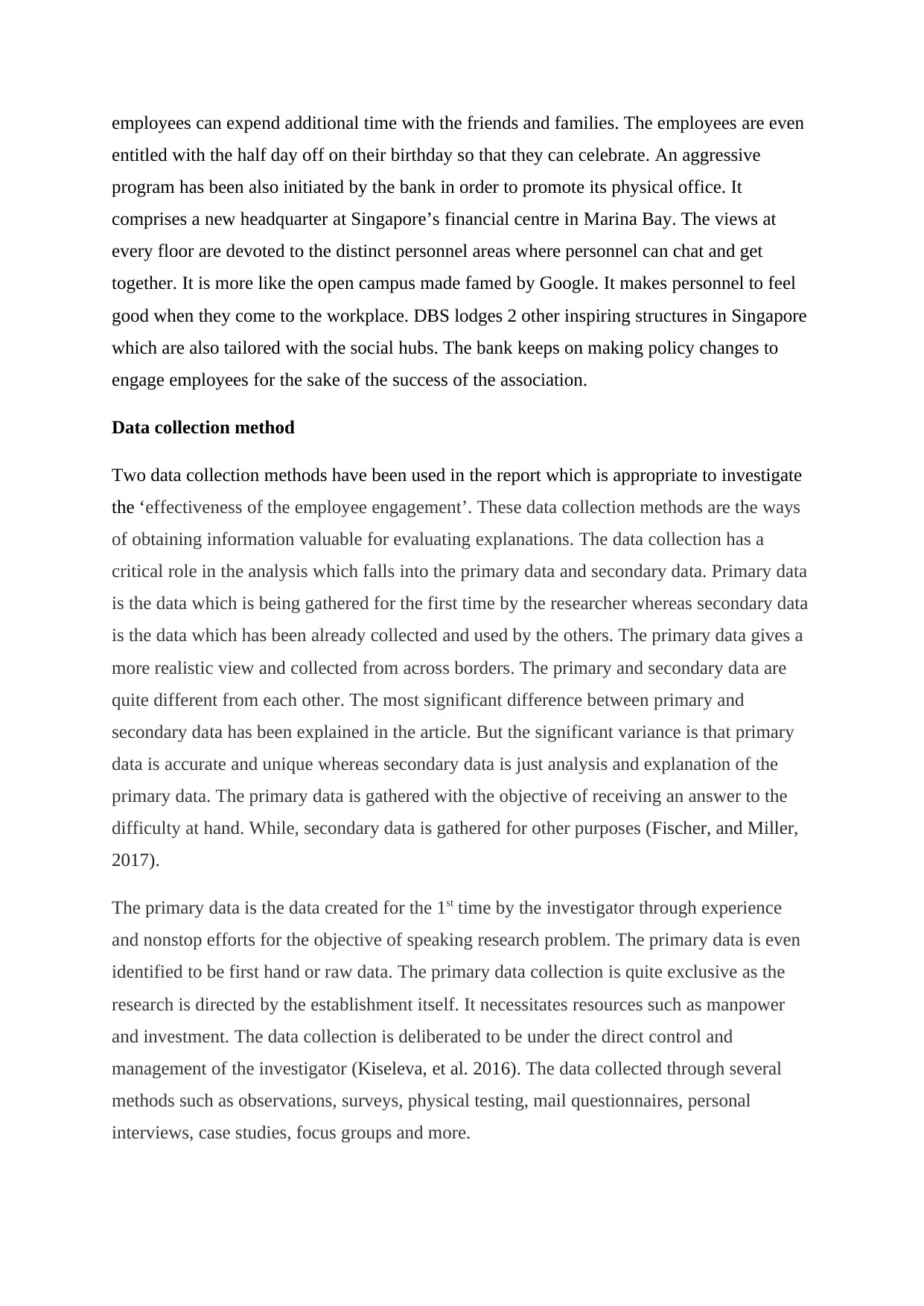
employees can expend additional time with the friends and families. The employees are even
entitled with the half day off on their birthday so that they can celebrate. An aggressive
program has been also initiated by the bank in order to promote its physical office. It
comprises a new headquarter at Singapore’s financial centre in Marina Bay. The views at
every floor are devoted to the distinct personnel areas where personnel can chat and get
together. It is more like the open campus made famed by Google. It makes personnel to feel
good when they come to the workplace. DBS lodges 2 other inspiring structures in Singapore
which are also tailored with the social hubs. The bank keeps on making policy changes to
engage employees for the sake of the success of the association.
Data collection method
Two data collection methods have been used in the report which is appropriate to investigate
the ‘effectiveness of the employee engagement’. These data collection methods are the ways
of obtaining information valuable for evaluating explanations. The data collection has a
critical role in the analysis which falls into the primary data and secondary data. Primary data
is the data which is being gathered for the first time by the researcher whereas secondary data
is the data which has been already collected and used by the others. The primary data gives a
more realistic view and collected from across borders. The primary and secondary data are
quite different from each other. The most significant difference between primary and
secondary data has been explained in the article. But the significant variance is that primary
data is accurate and unique whereas secondary data is just analysis and explanation of the
primary data. The primary data is gathered with the objective of receiving an answer to the
difficulty at hand. While, secondary data is gathered for other purposes (Fischer, and Miller,
2017).
The primary data is the data created for the 1st time by the investigator through experience
and nonstop efforts for the objective of speaking research problem. The primary data is even
identified to be first hand or raw data. The primary data collection is quite exclusive as the
research is directed by the establishment itself. It necessitates resources such as manpower
and investment. The data collection is deliberated to be under the direct control and
management of the investigator (Kiseleva, et al. 2016). The data collected through several
methods such as observations, surveys, physical testing, mail questionnaires, personal
interviews, case studies, focus groups and more.
entitled with the half day off on their birthday so that they can celebrate. An aggressive
program has been also initiated by the bank in order to promote its physical office. It
comprises a new headquarter at Singapore’s financial centre in Marina Bay. The views at
every floor are devoted to the distinct personnel areas where personnel can chat and get
together. It is more like the open campus made famed by Google. It makes personnel to feel
good when they come to the workplace. DBS lodges 2 other inspiring structures in Singapore
which are also tailored with the social hubs. The bank keeps on making policy changes to
engage employees for the sake of the success of the association.
Data collection method
Two data collection methods have been used in the report which is appropriate to investigate
the ‘effectiveness of the employee engagement’. These data collection methods are the ways
of obtaining information valuable for evaluating explanations. The data collection has a
critical role in the analysis which falls into the primary data and secondary data. Primary data
is the data which is being gathered for the first time by the researcher whereas secondary data
is the data which has been already collected and used by the others. The primary data gives a
more realistic view and collected from across borders. The primary and secondary data are
quite different from each other. The most significant difference between primary and
secondary data has been explained in the article. But the significant variance is that primary
data is accurate and unique whereas secondary data is just analysis and explanation of the
primary data. The primary data is gathered with the objective of receiving an answer to the
difficulty at hand. While, secondary data is gathered for other purposes (Fischer, and Miller,
2017).
The primary data is the data created for the 1st time by the investigator through experience
and nonstop efforts for the objective of speaking research problem. The primary data is even
identified to be first hand or raw data. The primary data collection is quite exclusive as the
research is directed by the establishment itself. It necessitates resources such as manpower
and investment. The data collection is deliberated to be under the direct control and
management of the investigator (Kiseleva, et al. 2016). The data collected through several
methods such as observations, surveys, physical testing, mail questionnaires, personal
interviews, case studies, focus groups and more.
Paraphrase This Document
Need a fresh take? Get an instant paraphrase of this document with our AI Paraphraser
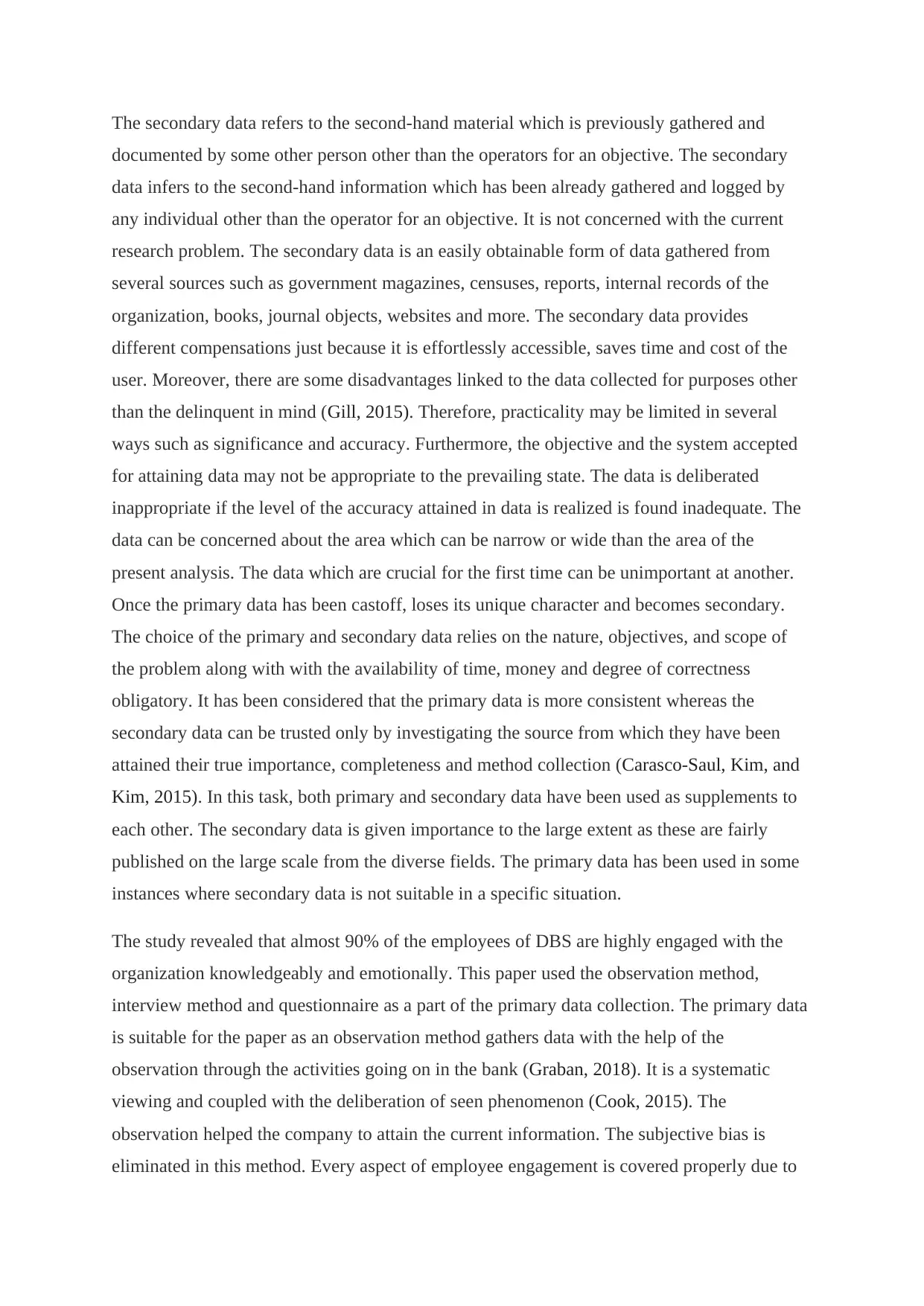
The secondary data refers to the second-hand material which is previously gathered and
documented by some other person other than the operators for an objective. The secondary
data infers to the second-hand information which has been already gathered and logged by
any individual other than the operator for an objective. It is not concerned with the current
research problem. The secondary data is an easily obtainable form of data gathered from
several sources such as government magazines, censuses, reports, internal records of the
organization, books, journal objects, websites and more. The secondary data provides
different compensations just because it is effortlessly accessible, saves time and cost of the
user. Moreover, there are some disadvantages linked to the data collected for purposes other
than the delinquent in mind (Gill, 2015). Therefore, practicality may be limited in several
ways such as significance and accuracy. Furthermore, the objective and the system accepted
for attaining data may not be appropriate to the prevailing state. The data is deliberated
inappropriate if the level of the accuracy attained in data is realized is found inadequate. The
data can be concerned about the area which can be narrow or wide than the area of the
present analysis. The data which are crucial for the first time can be unimportant at another.
Once the primary data has been castoff, loses its unique character and becomes secondary.
The choice of the primary and secondary data relies on the nature, objectives, and scope of
the problem along with with the availability of time, money and degree of correctness
obligatory. It has been considered that the primary data is more consistent whereas the
secondary data can be trusted only by investigating the source from which they have been
attained their true importance, completeness and method collection (Carasco-Saul, Kim, and
Kim, 2015). In this task, both primary and secondary data have been used as supplements to
each other. The secondary data is given importance to the large extent as these are fairly
published on the large scale from the diverse fields. The primary data has been used in some
instances where secondary data is not suitable in a specific situation.
The study revealed that almost 90% of the employees of DBS are highly engaged with the
organization knowledgeably and emotionally. This paper used the observation method,
interview method and questionnaire as a part of the primary data collection. The primary data
is suitable for the paper as an observation method gathers data with the help of the
observation through the activities going on in the bank (Graban, 2018). It is a systematic
viewing and coupled with the deliberation of seen phenomenon (Cook, 2015). The
observation helped the company to attain the current information. The subjective bias is
eliminated in this method. Every aspect of employee engagement is covered properly due to
documented by some other person other than the operators for an objective. The secondary
data infers to the second-hand information which has been already gathered and logged by
any individual other than the operator for an objective. It is not concerned with the current
research problem. The secondary data is an easily obtainable form of data gathered from
several sources such as government magazines, censuses, reports, internal records of the
organization, books, journal objects, websites and more. The secondary data provides
different compensations just because it is effortlessly accessible, saves time and cost of the
user. Moreover, there are some disadvantages linked to the data collected for purposes other
than the delinquent in mind (Gill, 2015). Therefore, practicality may be limited in several
ways such as significance and accuracy. Furthermore, the objective and the system accepted
for attaining data may not be appropriate to the prevailing state. The data is deliberated
inappropriate if the level of the accuracy attained in data is realized is found inadequate. The
data can be concerned about the area which can be narrow or wide than the area of the
present analysis. The data which are crucial for the first time can be unimportant at another.
Once the primary data has been castoff, loses its unique character and becomes secondary.
The choice of the primary and secondary data relies on the nature, objectives, and scope of
the problem along with with the availability of time, money and degree of correctness
obligatory. It has been considered that the primary data is more consistent whereas the
secondary data can be trusted only by investigating the source from which they have been
attained their true importance, completeness and method collection (Carasco-Saul, Kim, and
Kim, 2015). In this task, both primary and secondary data have been used as supplements to
each other. The secondary data is given importance to the large extent as these are fairly
published on the large scale from the diverse fields. The primary data has been used in some
instances where secondary data is not suitable in a specific situation.
The study revealed that almost 90% of the employees of DBS are highly engaged with the
organization knowledgeably and emotionally. This paper used the observation method,
interview method and questionnaire as a part of the primary data collection. The primary data
is suitable for the paper as an observation method gathers data with the help of the
observation through the activities going on in the bank (Graban, 2018). It is a systematic
viewing and coupled with the deliberation of seen phenomenon (Cook, 2015). The
observation helped the company to attain the current information. The subjective bias is
eliminated in this method. Every aspect of employee engagement is covered properly due to
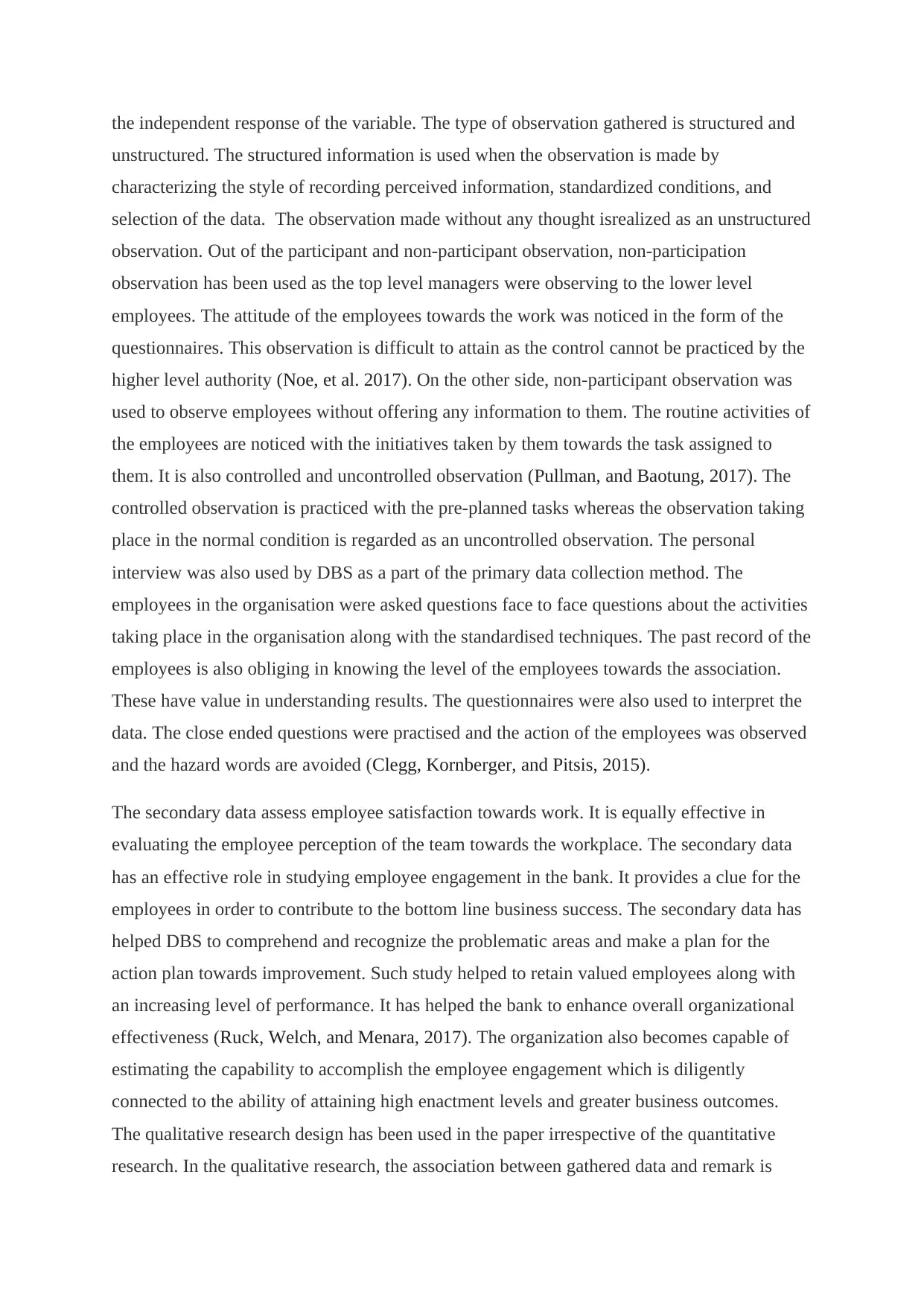
the independent response of the variable. The type of observation gathered is structured and
unstructured. The structured information is used when the observation is made by
characterizing the style of recording perceived information, standardized conditions, and
selection of the data. The observation made without any thought isrealized as an unstructured
observation. Out of the participant and non-participant observation, non-participation
observation has been used as the top level managers were observing to the lower level
employees. The attitude of the employees towards the work was noticed in the form of the
questionnaires. This observation is difficult to attain as the control cannot be practiced by the
higher level authority (Noe, et al. 2017). On the other side, non-participant observation was
used to observe employees without offering any information to them. The routine activities of
the employees are noticed with the initiatives taken by them towards the task assigned to
them. It is also controlled and uncontrolled observation (Pullman, and Baotung, 2017). The
controlled observation is practiced with the pre-planned tasks whereas the observation taking
place in the normal condition is regarded as an uncontrolled observation. The personal
interview was also used by DBS as a part of the primary data collection method. The
employees in the organisation were asked questions face to face questions about the activities
taking place in the organisation along with the standardised techniques. The past record of the
employees is also obliging in knowing the level of the employees towards the association.
These have value in understanding results. The questionnaires were also used to interpret the
data. The close ended questions were practised and the action of the employees was observed
and the hazard words are avoided (Clegg, Kornberger, and Pitsis, 2015).
The secondary data assess employee satisfaction towards work. It is equally effective in
evaluating the employee perception of the team towards the workplace. The secondary data
has an effective role in studying employee engagement in the bank. It provides a clue for the
employees in order to contribute to the bottom line business success. The secondary data has
helped DBS to comprehend and recognize the problematic areas and make a plan for the
action plan towards improvement. Such study helped to retain valued employees along with
an increasing level of performance. It has helped the bank to enhance overall organizational
effectiveness (Ruck, Welch, and Menara, 2017). The organization also becomes capable of
estimating the capability to accomplish the employee engagement which is diligently
connected to the ability of attaining high enactment levels and greater business outcomes.
The qualitative research design has been used in the paper irrespective of the quantitative
research. In the qualitative research, the association between gathered data and remark is
unstructured. The structured information is used when the observation is made by
characterizing the style of recording perceived information, standardized conditions, and
selection of the data. The observation made without any thought isrealized as an unstructured
observation. Out of the participant and non-participant observation, non-participation
observation has been used as the top level managers were observing to the lower level
employees. The attitude of the employees towards the work was noticed in the form of the
questionnaires. This observation is difficult to attain as the control cannot be practiced by the
higher level authority (Noe, et al. 2017). On the other side, non-participant observation was
used to observe employees without offering any information to them. The routine activities of
the employees are noticed with the initiatives taken by them towards the task assigned to
them. It is also controlled and uncontrolled observation (Pullman, and Baotung, 2017). The
controlled observation is practiced with the pre-planned tasks whereas the observation taking
place in the normal condition is regarded as an uncontrolled observation. The personal
interview was also used by DBS as a part of the primary data collection method. The
employees in the organisation were asked questions face to face questions about the activities
taking place in the organisation along with the standardised techniques. The past record of the
employees is also obliging in knowing the level of the employees towards the association.
These have value in understanding results. The questionnaires were also used to interpret the
data. The close ended questions were practised and the action of the employees was observed
and the hazard words are avoided (Clegg, Kornberger, and Pitsis, 2015).
The secondary data assess employee satisfaction towards work. It is equally effective in
evaluating the employee perception of the team towards the workplace. The secondary data
has an effective role in studying employee engagement in the bank. It provides a clue for the
employees in order to contribute to the bottom line business success. The secondary data has
helped DBS to comprehend and recognize the problematic areas and make a plan for the
action plan towards improvement. Such study helped to retain valued employees along with
an increasing level of performance. It has helped the bank to enhance overall organizational
effectiveness (Ruck, Welch, and Menara, 2017). The organization also becomes capable of
estimating the capability to accomplish the employee engagement which is diligently
connected to the ability of attaining high enactment levels and greater business outcomes.
The qualitative research design has been used in the paper irrespective of the quantitative
research. In the qualitative research, the association between gathered data and remark is
⊘ This is a preview!⊘
Do you want full access?
Subscribe today to unlock all pages.

Trusted by 1+ million students worldwide
1 out of 18
Related Documents
Your All-in-One AI-Powered Toolkit for Academic Success.
+13062052269
info@desklib.com
Available 24*7 on WhatsApp / Email
![[object Object]](/_next/static/media/star-bottom.7253800d.svg)
Unlock your academic potential
Copyright © 2020–2025 A2Z Services. All Rights Reserved. Developed and managed by ZUCOL.





